Key takeaways from last week’s developments:
No significant changes occurred in Ukraine last week; Most Russian operations occurred in the Donetsk Oblast, where they slightly extended territorial control; From a strategic point of view, the frontline remained deadlocked as both sides are preparing for the Ukrainian counteroffensive;
Russians made no gains in the Kharkiv Oblast last week; As all ground attacks were repelled, Moscow remained committed to conducting artillery and missile attacks across the region;
The Kreminna area in the Luhansk Oblast remained the heaviest-shelled region in Ukraine; Yet despite this concentration of artillery power, Russians made no advances in this sector or across the wider Luhansk region;
Russians probably captured some territory west near Ocheretyne and Novobakhmutivka, extending their control to Krasnohorivka; All other attempts to shift the frontline;
Russians continued to extend their gains in Bakhmut, where they now control around 75 per cent of the city; Ukrainian positions in the city are increasingly squeezed;
The situation in the Zaporizhihia Oblast remained unchanged; Ukrainians now deploy at least seven manoeuver brigades in the region with an additional three territorial defence brigades;
No changes were reported in the Kherson Oblast; Ukrainians did not extend territorial control on Dnipro’s southern bank; on Saturday, a Ukrainian drone attack badly damaged a fuel storage facility in Crimea;
The Belarusian Armed Forces continued a readiness drill, but we did not witness a change in their posture;
General outlook
Last week, Russians conducted the first major missile strike on targets across Ukraine since early March. After a 50-day pause, on Friday, Russian Tu-95 strategic bombers fired 23 cruise missiles from the Caspian Sea toward Ukraine’s central, eastern and southern regions. Kyiv claimed that the strike sought to hit Ukrainian reservists’ concentration areas. Twenty-one missiles were intercepted. On Sunday night, Russians conducted another strike. It involved 18 cruise missiles, of which 15 were reportedly shot down.
Looking at previous operations, last week’s strikes were the second and third smallest attacks since the bombing campaign started in September 2023. Another unusual aspect is that they occurred at a three-day interval. Previously, Russians launched such strikes around every fortnight, although clearly, they were much bigger in size. It is too early to say whether this heralds a change in how Moscow will run its bombing campaign from now on. But given the last two strikes, Russians may focus on conducting smaller strikes more often.
Nevertheless, we assess that the continuation of the Russian campaign will not significantly impact the situation on the ground. Not only are the strikes too small and have happened (so far) too rarely, but the Ukrainian air defence is also too effective, especially when strikes are small. Indeed, last week Ukrainians shot down 91 and 83 per cent of incoming missiles, or to put it differently, out of 39 missiles fired, only five flew past air defences, according to the Ukrainian General Staff. Even assuming these missiles reached their designated targets, they are unlikely to have caused significant damage.
Regarding the battlefield situation, we continue to see no major changes. The frontline shifted slightly in the Donetsk Oblast but remained unchanged in the Kharkiv, Luhansk, Zaporozhihia and Kherson Oblasts.
Russian focus in the Kharkiv Oblast is more on artillery strikes than ground operations. In the Luhansk Oblast, Russian ground attacks seemingly decreased, but the Kreminna area remained the heaviest-shelled region in Ukraine. Russian operations in the Donetsk Oblast were only successful in Bakhmut and west of Novobakhmutivka. Russian sources continued to express deep concern about the build-up of Ukrainian forces in the Zaporizhihia region. However, ground attacks there were also somewhat subdued. Lastly, we were correct to advise caution regarding reports suggesting the deployment of Ukrainian forces on Dnipro’s left bank. Last week confirmed that the Ukrainian presence was temporary, but more importantly, it was not used to expand Kyiv’s territorial control deeper inland.
Ultimately, except for Bakhmut, the war is in limbo as both sides await for the Ukrainian offensive to begin.
When speaking about it, Ukraine’s President, Volodymyr Zelensky, said that Kyiv would not delay its actions despite a lack of F-16. Modern combat aircraft and long-range precision missiles have long been considered priority items. Still, it is clear that the West is unwilling to provide these capabilities to Ukrainians at this stage of the war.
At the same time, NATO’s Secretary-General Jens Stoltenberg stated that the alliance delivered 98% of its pledged military aid to Ukraine, including over 1,550 armoured vehicles, 230 tanks, and other equipment, including vast amounts of ammunition. Meanwhile, 31 M1 Abrams will arrive in Germany from the United States in the next few weeks, when Ukrainian crews will be trained over ten weeks. Some Bradley infantry fighting vehicles are now in Ukraine, too, although it is unclear how many. But we know the newly established 47th Mechanised Brigade will field them along Slovanian-supplied M-55 tanks. It is worth watching this particular unit because its appearance near the frontline will show where the attack may begin. In the meantime, Russian sources claimed last week that two mechanised brigades of the 10th Army Corps (a newly established formation earmarked for the counteroffensive) had been moved to the Zaporizhihia Oblast. We understand that out of three new corps, the 10th has the highest readiness level, so the deployment of the 116th and 118th Mechanised Brigades may suggest a new phase in Ukrainian preparations for the counterattack: the movement to concentration areas.
Summary of losses
According to the Russian Ministry of Defence, since the start of the war, Ukraine has lost 413 aircraft (+2), 230 helicopters (+2), 3,905 UAVs (+71), 421 anti-aircraft missile systems (launchers?)(+6), 8,920 tanks and other armoured combat vehicles (+111), 1,095 MLRS launchers (+2), 4,695 field artillery guns and mortars (+48), as well as 9,882 units of special military vehicles (+161).
According to the Ukrainian General Staff, Russia lost (eliminated) 190,510 personnel (+4,090), 3,699 tanks (+24), 7,189 armoured combat vehicles (+58), 2,914 artillery systems (+77) and 544 MLR systems (+5), 295 anti-aircraft systems (+6), 308 aircraft (0) and 294 helicopters (0), and 2,475 UAVs (+73), 5,842 vehicles and fuel tanks (+112), 932 cruise missiles (+21), 18 warships and boats (0) and 357 special vehicles (+18).
(Numbers in parentheses denote a weekly change)
Military situation in Belarus
Last week did not bring any significant changes to the military situation in Belarus. Despite the continuation of major training events, the overall activity of the Belarusian Armed Forces decreased. Activities of the Russian forces in Belarus declined as well.
Over the past seven days, representatives of the Belarusian political leadership made no significant announcements. High-rank officers participated in several noteworthy events, but most had an international character.
On Thursday, Belarusian Minister of Defence, Lt. Gen. Viktor Khrenin, met with his Chinese and Iranian counterparts. During the first meeting with Col. Gen. Li Shangfu, he spoke about the state and prospects of cooperation in the military sphere, noticing the necessity of further collaboration as a part of the strategic partnership.
The Head of the Belarusian MoD provided similar statements during the second event with Brig. Gen. Mohammad Reza Ashtiani from Iran. According to the official statement, both generals discussed the significant potential for developing practical cooperation and strengthening military contacts, claiming that consolidating the joint efforts would positively affect peace and security in the world.
The third meeting occurred a day later when Khrenin met with the Indian Minister of Defence, Rajnath Singh, to discuss the cooperation between states and Belarusian plans to join the Shanghai Cooperation Organization (SCO).
Shortly before the last meeting, the Belarusian Minister of Defence participated in the discussion of the SCO Defence Ministers. The event occurred in New Delhi, where officials exchanged views on challenges and threats to national security, as well as measures to neutralise them. Khrenin presented the Belarusian position linked to the state and prospects of regional and international security. His position was that the Russo-Ukrainian conflict triggered the transformation of the global relations system and security architecture developed after World War II. We are now in the “hot phase” of the civilisational confrontation between the West and the East.
On Friday, Belarusian International Military Cooperation Department representatives hosted a meeting with US Defence Attaché in Belarus, Lt. Col. Jason Tucker. The event involved two Belarusian lieutenant colonels who spoke about regional security affairs, most likely linked to the upcoming Defender Europe-2023 exercise.
When it comes to the domestic events of military officials, they generally can be divided into categories. The first pertains to the ongoing combat readiness check, while the second to the start of the spring conscription.
Regarding the first, the participation of the Western Operational Command Commander, Col. Vladimir Bely, in the readiness review of unspecified (sub)units is noteworthy. On Tuesday, Bely checked the provision of military personnel with the necessary equipment and the unit’s readiness to perform intended tasks.
Four days later, the Chief of Belarusian General Staff, Major General Viktor Gulevich, attended an analogical event. Specifically, he arrived at one of the Belarusian training grounds, where he spoke about “unfriendly steps” of Belarusian neighbours. Gulevich brought the involvement of NATO forces in the Defender Europe-2023 exercise, as well as the large-scale Anakonda drills of the Polish Armed Forces, as examples. Gulevich stressed that the Belarusian Army is ready to repel any foreign aggression.
The Secretary of the Belarusian Security Council, Lt. Gen. Alexander Volfovich, provided similar declarations. According to him, all ongoing exercises and inspections were intended to uphold the ability to maintain the readiness of the entire national security system. Volfovich stressed that peacetime structures were minimally sufficient to address the current risks and challenges but added that more than 1.5 million people would defend Belarus in case of an attack.
Regarding conscription, the dispatch of spring conscripts to the selected Belarusian formations (72nd Joint Training Center, SOF brigades and Minsk Military Commandant’s Office) officially started on Wednesday. At the same time, the 72nd Joint Training Center, 19th Mechanised Brigade and 1052nd Radiotechnical Battalion (Wednesday), as well as the 30th Railway Brigade (Thursday) and Air Force and Air Defence Forces Command (Friday) hosted farewell ceremonies for their (conscripted) service members, who just finished their military service.
The Belarusian Hajun Project provided information about the possible upcoming mobilisation readiness check of the 38th Air Assault Brigade. As noted, the Grodno City Military Commissariat started the delivery of call-up notices to reservists from an unspecified SOF brigade. As the 103rd Airborne Brigade recently finished the mobilisation check and the 5th Spetsnaz Brigade also recently discharged reserve officers, it appears that the planned readiness check will involve the only remaining SOF brigade, namely the 38th Air Assault Brigade.
Hajun also provided information about possible Territorial Defence Forces exercise in Gomel. According to the public procurement data, the Gomel City Executive Committee ordered camouflage nests, road spikes, and other necessary equipment for the drills. The Belarusian Hajun claimed that exercises would likely start by 15MAY and would likely involve up to 100 reserve service members.
Last week, the Belarusian Armed Forces continued their combat readiness check, which involved elements of the 11th Mechanised Brigade, Special Purpose Detachment of the 432nd Main Military Clinical Medical Center and most likely 339th Mechanised Battalion of the 120th Mechanised Brigade.
On Wednesday, the Belarusian MoD announced the end of drills by Belarusian service members in Russia. The exercise related to an Iskander battalion of the 465th Missile Brigade that finished the training cycle related to the exploitation, maintenance and combat-training launches from the Iskander-M missile system (also with the use of nuclear munitions). The deployment of the brigade’s personnel could have also occurred within the context of an ongoing readiness check of the Belarusian Armed Forces, although this was not officially confirmed.
At the same time, elements of the Minsk Military Commandant’s Office started three days long special-tactical exercises, while mortar subunit(s) of the 103rd Airborne Brigade participated in the firing classes at the Losvido Training Ground.
The Belarusian Air Force conducted extensive training exercises from Thursday to Saturday, likely related to supporting ground operations at various training ranges.
Over the past seven days, Belarusian military transfers were relatively low. The most noteworthy movement included ponton bridge elements (Wednesday), a BTR-equipped battalion (Thursday) and a possible S-300 battery (Saturday).
The activity of the Russian forces decreased. Last week, only a single Mi-8 helicopter and the An-12 (RF-12556) cargo aircraft arrived in Belarus. There was a significant reduction in ground movements, with only one large convoy of 30 trucks observed on Wednesday.
Please click here to access the database of all Belarusian exercises since 1JAN2023.
The situation at selected axes and directions
Kharkiv direction
As expected, we saw no changes in the overall situation in the Kharkiv Oblast. No significant events occurred in the area last week. Russian ground assaults were expectedly confined to Hrayanykivka, Masiutivka and Krohmalne.
Last week, Russians did not undertake any cross-border ground attacks. But, they conducted daily missile and artillery attacks on cities and villages across the region. In this aspect, Russian operations continued unabated.
We continue to see no indications that the situation in the area will change. Russian formations in this part of Ukraine are centred around the 6th Combined Arms Army, the weakest and least developed army in the Russian Ground Forces pre-war. It is unlikely that the formation was strengthened to the point that it has become a formidable fighting force. In fact, out of all directions, the Russian military leadership continues to deprioritise the Kharkiv Oblast.
Kyiv could benefit from this deprioritisation, but at the same time, we have not seen any attempts to shape the battlefield in the Kharkiv Oblast or efforts to significantly augment Ukrainian presence in the region. The proximity to the state border and the threat of attack on Ukrainian flanks further decrease the chances of a Ukrainian attack in this part of Ukraine.
Luhansk Direction
Last week did not deliver any changes in the Luhansk Oblast. The frontline remained deadlocked as all Russian attacks were repelled. Throughout the week, the Russian MoD informed about its successful attempts to interdict Ukrainian troop deployments and rotations near the frontline. For instance, on Friday, Yaroslav Yakimin, a Russian Western Group of Forces Spokesperson, said that in the Kupyansk direction, Russian troops destroyed three Ukrainian reconnaissance groups from the 14th and 92nd brigades near Masiutivka and Novoselivske. Two troop rotation attempts were also disrupted near Dvorichna. A missile strike also hit a Ukrainian command post in Kupyansk.
While it is possible that this happened, we continue to see no evidence suggesting a large-scale deployment of either Russian or Ukrainian sources into the oblast.
Nevertheless, we believe that the frontline in this part of Ukraine is unlikely to be altered as both sides continue to conduct positional battles with artillery support. The likelihood of a breakthrough in the region remains minimal.
No changes occurred when it came to how the battles were distributed. Few attacks were conducted in the Svatove axis, while most activities occurred along the Ploshchanka – Bilohorivka line. In this area, Russians focused on Makiivka, Torske and Nevske. Despite conducting daily attacks, they made no new territorial gains.
According to Serhiy Cherevaty, the Eastern Group of the Ukrainian Armed Forces spokesman, the Lyman – Kupyansk direction remained the most heavily shelled region in Ukraine. On 27APR (Thursday), he claimed Russians shelled Ukrainian positions 566 times. Although admittedly, given the small area Ukrainians control in Bakhmut, the fire density there is higher than in the Luhansk Oblast.
The intensity of Russian strikes also fluctuates. Based on Cherevaty’s figures, Russians fired 432 times on Ukrainian positions on 24APR and 379 on 25APR. Although daily figures are no longer regularly provided, we assess that Russians shell Ukrainian positions around 450 times a day on average. Yet, this did not translate into any successes on the battlefield in the area, as the frontline in the Serebryansky forest and near Dibrova did not change.
Last week, Russians utilised the TOS-1 heavy flamethrower system against Ukrainian forces near Bilohorivka, but this was not followed up with ground activity.
Last week, Ukrainians conducted at least two HIMARS strikes on Russian targets. Four missiles hit an unspecified target in Bryanka on 29APR. On 24APR, Ukrainians also hit an oil depot in Rovenky.
Donetsk Oblast Direction
Last week brought additional Russian gains in Bakhmut and limited advances west of Novobakhmutivka. All Russian attacks in other parts of the region were repelled.
As stated in the previous update, discussions about the exhaustion of Wagner PMC’s offensive potential were premature. The past seven days confirmed our assessment. Wagner fighters continued to make steady gains in Bakhmut. They came despite comments made by Wagner’s head, Yevgeny Prigozhin, during an interview with Kremlin-linked journalist/blogger WarGonzo. Probably the most important claim he made pertained to a possible withdrawal of Wagner forces from Bakhmut. Progizin once again complained about a lack of ammunition, blaming the Russian MoD for reducing its allowance. Specifically, he stated that the organisation received 800 of the 4,000 shells it requested per day. But, Wagner would ideally like to receive 80,000 shells that it obtained from the MoD before the feud began. He also added that if the current situation does not improve, Wagner will either withdraw from Bakhmut or “stay there and die”.
There are a couple of items to unpack here. Firstly, the number of artillery shells. It is unlikely that Wagner received 80,000 shells a day previously, and even if it did receive such an amount now, the organisation would probably be unable to utilise them fully. In March, Ukrainian Minister of Defence, Oleksii Reznikov, stated that Russian artillery consumption peaked at over 60,000 shells a day during the summer of 2022. WSJ claimed that 30,000 were fired in the same period. Back then, Russians fought in the northern Kherson Oblast and maintained positions in most of the Kharkiv region, so the frontline was much larger. It is not possible that Wagner alone used up 80,000 shells for their attacks from Popasna towards Soledar-Bakhmut. We also find it unlikely that the organisation has enough guns to significantly increase its fire rate, even if it started receiving thousands of shells.
Secondly, nothing indicates that Wagner will pull back from Bakhmut now. Wagner has been fighting for the city since August. Since then, with various paces of attacks and very high losses, they are confirmed to have captured around 75 per cent of the town. Ukrainian positions in the western parts of Bakhmut are increasingly squeezed, and even with limited access to artillery shells, Wagner can inflict heavy losses on Ukrainians. Unless Ukrainians counterattack and given the current tempo of attacks, Wagner will probably capture the city within the next two weeks. Indeed, the cooperation with regular Russian formations allows Wagner to focus entirely on urban battles and eliminate Ukrainian pockets of resistance. Previous Prigozhin’s threats about a pullback from Wagner or the elimination of the organisation as a fighting force have not materialised either. As a result, seeing the mismatch between rhetoric and actions on the ground, we see no reasons to expect a change in operations in Bakhmut or Wagner’s withdrawal from the city. The organisation will continue to advance into the western parts of the city.
Let’s look at the frontline starting from the northern parts of the region. In general, no changes occurred near Verkhnokamyanske and Vyimka. According to a Ukrainian source, Akhmat units (Chechen fighters) occupy a compressor station near Spirne. The fact that Russians conducted offensive actions near the village, followed by a reported Ukrainian counterattack, suggests small frontline changes in this sector.
The frontline remained stable in Vasiukivka, Fedorivka, Rozdolivka, and Vesele.
Russians made no progress in areas around Soledar. It pertains to Vasiukivka, Fedorivka, Rozdolivka, and Vesele and Orikhovo – Vasylivka, Hryhorivka, Bohdanivka and Minkivka.
Russians continued attacking Ukrainian positions near Khromove but made no progress near the 0506 road last week. It thus seems that Ukrainians managed to stabilise the situation in this area, and the threat of Russians permanently capturing the road dissipated.
Russians made steady gains in Bakhmut last week. They reached the junction of Tchaikovskoho and Yubileyna Streets. They captured the industrial vocational college, meaning they took control over the main entrance to the city, both from Ivanivske and Khromove.
Russians also attacked Korsunskoho Street, near high rise building, but Ukrainian troops held their positions. According to the Russian source, Ukrainians blow up a building on Chaikovskoho 105 Street. By such actions, Ukrainian troops tried to slow Russians down and deprive them of elevated positions in the city.
Over the past three days, Ukrainian and Russian bloggers marked significant Russian gains on their maps. In this respect, our assessment differs (Russian advances are smaller) due to a lack of additional visual evidence.
Ukrainian bloggers claimed that the attackers were gathering reserves and conducting artillery preparations for the final assault on the western part of the city.
According to a Ukrainian soldier deployed in the city, Russians stormed Ukrainian positions 8—10 times a day. In some northern parts of the city, he claimed, the defenders attempted to counterattack, but he did not provide any details about the results of such actions. The soldier added that Russians continued to have the advantage in artillery and aviation.
A Russian source claimed that over 85 per cent of the city was already under Wagner’s control. But, we assess that this number is much smaller, at 75 per cent.
No frontline changes were reported along the Predtychyne – Ivanivske line. However, Russians became more active near the latter late in the week, conducting numerous artillery and ground attacks. It is unclear whether this heralds a shift in operations around Bakhmut, but Russians may plan more coordinated attacks on Ivanivske to cut Ukrainian off from Bakhmut.
Ukrainians reportedly counterattacked near Krasnohorivka, but no further information about this development was provided.
According to the Russian journalist, Russian troops managed to push Ukrainian units back from the H20 highway near Novokalynove.
A Russian source said that the Russian 132nd Motor Rifle Brigade advanced from the H20 highway to the railway line from Ocheretyne to Novobakhmutivka, extending the bridgehead to Krasnohorivka. Elements of the Ukrainian 35th Naval Infantry Brigade and the 88th Mechanised Brigade were deployed to reinforce the Novokalynove – Keramik line. To the south, assault detachments of the 1st Slovyansk Brigade, supported by tanks, reportedly managed to advance northeast of Vodyane, occupying one of the strongholds of the Ukrainian 53rd Mechanised Brigade.
Russian troops slightly advanced near Nevelske. Ukrainian sources did not report changes near the village. Also, neither Russian nor Ukrainian sources reported changes near Pervomaiske, Tonenke and Severne.
Russian attempts to inch close to Avdiivka also failed. According to Colonel Oleksiy Dmytrashkivskyi, Joint Press Center of the Tavriisk Direction Spokesman, on 24APR and 25APR, Russians fired almost 500 times on Ukrainian positions from various artillery systems. The number of strikes is comparable to February 2023 figures, he added. Russians also conducted 22 ground attacks in Mariinka and Avdiivka directions. Dmytrashkivskyi claimed that there was information about the movement of a tank brigade towards the Avdiivka area. He expects Russians to utilise this equipment soon as they used no tanks to attack Ukrainian positions for the previous several days.
No changes were reported near Mariinka, where Russians attacked the city’s southern and northern outskirts and towards Pobieda. However, despite conducting daily ground, air and artillery attacks, Ukrainians continue to hold positions in the western parts of town. Denis Pushylin, the head of the Donetsk People’s Republic, said that all Ukrainian positions in Marinka had come under Russian fire control, and most of the city blocks had been captured. The fact that Ukrainian positions are under Russian fire control is nothing new. Neither was his claim that Russians controlled most of the city.
No changes were reported in the Vuledar area. It appears that the Russian badly mauled 155th Naval Infantry Brigade was reconstituted and sent back to battle. During the week, it was reportedly involved in combat operations near Mykylski Dachi.
In the Vremivka area, Ukrainian troops reinforced their positions near the Vremivka – Velyka Novosilka line. An infantry battalion of the 1st Separate Tank Brigade moved towards Shahtarske, and the second was sent towards Burlatske. The brigade also has units deployed near Novohryhorivka and a self-propelled howitzer unit near Novopil.
Zaporizhzhia direction
The situation in the Zaporizhihia Oblast remained unchanged last week. Compared to events that unfolded in the Kherson Oblast, we could even say that last week proved uneventful in the region.
Russians continued to express concern about the build-up of Ukrainian forces in the region. Early in the week, a Russian source stated that Kyiv might launch an offensive near Orikhiv, aiming to reach Vesele.
He also claimed that the Ukrainian Armed Forces faced shortages, particularly in mobile air defence systems. Consequently, in the event of a large-scale offensive, there is a high risk of them being hit hard by Russian aviation.
The Russian source stated that elements of the 116th and 118th Mechanised Brigades of the 10th Army Corps had arrived near Odarivka, Tavriiske, and Slavne. The source claimed these units would be tasked with making a breakthrough towards Melitopol. Artillery battalions are being prepared along the Slavne-Odarivka line, while three mechanised battalions are being prepared to attack towards Robotyne-Ocheretuvate to open up a route towards Melitopol. The source added that a HIMARS battalion was deployed to Stepnogorsk after the civilian population was forcefully evacuated. Personnel of the 128th Mountain Assault Brigade was also reportedly spreading information about the preparations for the offensive being in the final stage.
Whereas the first part of the story could be true, It is doubtful that the 128th Mechanised Brigade personnel would disseminate any information about the counteroffensive. Based on our conversations in Kyiv, we can confirm that Ukrainian operational security is very tight. Only a few people knew when exactly the Kharkiv Offensive would start. Soldiers on the ground found out 24-48 hours before the attack. So unless the counteroffensive is about to start, any reports about people walking around spreading information are untrue. Unless, of course, Ukrainians purposefully spread fake news as a part of their PSYOPS.
Reportedly, personnel from the Russian 1430th Motor Rifle Regiment recorded a video message claiming that Ukrainian forces had concentrated troops in the Orikhiv area in the Zaporizhzhia Oblast and that Russian fortifications were made only for show.
Another source said that Ukraine had concentrated reserves near Zaporizhzhia and Hylaipole. The source believed that after the end of the muddy weather, Ukrainian troops would attack towards Polohy, Tokmak and Vasylivka. Another scenario under consideration pertained to river crossing operations near Enerhodar, Nova Kakhovka and Oleshky, but we consider these low-probability events.
Based on previous Russian reports, the following Ukrainian units are presently deployed to the Zaporizhihia Oblast:
116th and 118th Mechanised Brigades;
128th Mountain Assault Brigade;
71st Jaeger Brigade;
46th Airmobile Brigade;
65th Mechanised Brigade;
1st Tank Brigade;
102nd, 108th, and 110th Territorial Defence Brigades;
At full peacetime strength, and excluding TDF, these units would altogether field over 22,000 men.
In the previous assessment, we warned about probable Ukrainian PSYOPS seeking to shape the battlefield, create confusion among Russians and collaborators, and decrease Russians’ willingness to fight. Early last week, a Ukrainian journalist stated that buses started arriving in various parts of the region. First to be evacuated are those “loyal to collaborators.” The following day, Russian sources denied these claims. We have also seen no indications suggesting ongoing evacuation efforts from the Zaprizhihia Oblast. It is probably too early for such actions. Still, we cannot exclude a scenario where a significant Russian pullback from the front will result in the collapse of Russian presence in the region, leading to a rout of both civilians and military personnel. However, assessing the probability of such a scenario is difficult.
We expect to see no changes in the broader Zaporizhihia region and expect to see changes in activities conducted by both sides. Russians will continue to improve fortifications and strengthen their defensive lines. Ukrainians will conduct limited ground attacks and missile strikes and undertake psy/info ops to influence opposing forces’ decision-making processes. We do not expect a Ukrainian counterattack this week.
Kherson direction and Crimea
Last week did not bring any fundamental changes in the Kherson Oblast. Following the events that unfolded on 23-24APR that saw the deployment of some Ukrainian forces on Dnipro’s left bank, we saw no continuation of Ukrainian efforts to extend the area they controlled. This lack of changes was in line with last week’s assessment when we wrote that “the Ukrainian presence on the Dnipro’s left bank is not a bridgehead that Ukrainians are currently actively trying to expand for further attacks deeper inland.”
At the current stage, it is unclear what Ukrainians wanted to achieve. Was this a battle-shaping operation seeking to force Russians to divert some of their forces from other areas, or were Ukrainian probing Russian responses and defences? We will probably answer these questions when the offensive starts, and with hindsight. Natalia Humeniuk, the spokesperson for the Ukrainian Command South, initially neither refuted nor confirmed information about the landing of Ukrainian troops across the Dnipro. She advised patience. However, mid-week, she stated that the counteroffensive had already begun and was taking small steps. Russian ammunition depots were being destroyed, and Ukrainian artillery was actively firing on the Russian concentration areas.
Throughout the week, Russian official and unofficial sources vehemently denied any claims that Ukrainians had established a permanent presence on the Dnipro’s southern bank. However, early in the week, some sources suggested that Ukrainians tried to gain a foothold on Velykyi Potomkin Island, south of Kindyika and west of Veletenske. Some stated that the UAF units were indeed shelled by Russian artillery, but no effort was made to establish a presence there. Indeed, the Moscow-installed head of the Kherson Oblast, Vladimir Saldo, stated that Ukrainians only conduct sporadic assaults across the river and that no permanent deployment of Ukrainian forces occurred.
Nevertheless, Russians remain concerned about the overall situation and the future of their positions in the region. A Russian source said that although Ukrainians were running some reconnaissance activities on the Dnipro Delta islands, there were signs of Ukrainian preparations for renewed attempts to land on Dnipro’s left bank near Oleshky, Nova Kakhovka and Enerhodar. At the same time, Ukrainians conducted artillery strikes on Stara Zburivka, Hola Prysytan, Kardashynka, Pidlisne, Oleshky, and Pischanivka. Ukrainian partisans also blew up a Russian roadblock near Oleshky. A Russian source asserted that Ukrainians concentrated 15,000 men in the Kherson direction.
On Saturday morning, Ukrainians reportedly conducted a drone strike on a Russian fuel storage facility in Sevastopol in Crimea. The facility belongs to the Limited Liability Company “Yuzhny Terminal”, and it is located near some important military bases in Sevastopol, such as the 810th Naval Infantry Brigade’s garrison. However, the Kozacha Lapan facility likely did not provide fuel to the Black Sea Fleet, as the unit’s main fuel storage facility is near Inkerman.
While it remains unknown where the Ukrainian counterattack will start, we will undoubtedly see more such attacks targeting the Russian ability to provision and move its forces in the near future. This does not indicate that the attacks will occur in the Kherson Oblast. But through these attacks, Kyiv keeps Moscow guessing about the true objective of the attack. As such, they fall within a larger Ukrainian battle-shaping operation that seeks to create good conditions and increase the chances of success of its counteroffensive.
We believe the offensive will comprise the main thrust and a couple of auxiliary axes of advance to confuse Russians about Ukrainian goals.
Outlook for the week of 1MAY-6MAY
In assessing the probability or likelihood of certain events, we use a set of terms proposed by the US Intelligence Community.
We have decided to introduce more accountability to our forecasts. Therefore, each weekly update assesses how correct (or incorrect) our predictions were. Here is what we said last week. Please also remember that while we try to remain as objective as possible regarding our performance, the reader will ultimately have to decide how (in)accurate we have been.
Last week’s forecast
“No indications herald a shift in how Russians and Ukrainians conduct their operations in the Kharkiv Oblast. Although Russians apparently increased the number of ground attacks on Ukrainian positions last week, we continue to see no signs of a more considerable change in Russian behaviour or no signs of a build-up. As such, the situation in the Kharkiv Oblast will highly likely not change this week. Russians will also almost certainly conduct artillery strikes across the oblast.” This assessment was correct, as no changes occurred in the region.
Score: 1/1
“The same pertains to the Luhansk Oblast, including the Kreminna area. Some tactical fluctuations will highly likely occur, but from an operational point of view, Russians are unlikely to make any territorial gains (capturing one village or more) this week.” This prognosis was also correct. The frontline in the oblast did not change last week, despite a heightened number of Russian artillery attacks.
Score: 1/1
“We are not making any changes to our assessment of the situation in the broader Donetsk Oblast, where Russians are unlikely to advance (capture one village or more). We also assess that Russian ground forces’ potential to capture Avdiivka is exhausted and that they are highly unlikely to make progress near the city.” Russians made no confirmed gains in the region. Unconfirmed reports suggested they advanced west of Novobakhmutivka, but no new villages or cities were captured. The attackers also did not inch closer to Avdiivka.
Score: 1/1
“When it comes to Bakhmut, let’s first start with the flanks. The southern part of the front is well protected, and it is unlikely that Russians will make any progress in this sector. However, the situation near Khromove is concerning. Last week, Russians physically severed the road, but their success was short-lived due to the quick deployment of Ukrainian units. There is roughly even chance that this week Russians will also make progress in this area. We believe that it is unlikely that Ukranians will pull back from Bakhmut this week, but concurrently, it is likely that Russians will advance within the city’s limits.” While Russians did not capture new territories near Khromove, they made steady gains in Bakhmut. Ukrainians also did not retreat from the town.
Score: 1/1
“We do not anticipate any major changes in the Zaporizhzhia Oblast, although it is possible that Ukrainians may become more active regarding ground attacks. No indications suggest a Ukrainian counteroffensive will occur in the oblast this week.” This prognosis was correct.
Score: 1/1
“Despite Ukrainians deploying small forces across the Dnipro, we also forecast no major changes in the Kherson Oblast. It is unlikely that these forces will be used to expand Ukrainian control south of the river.” Although it was difficult to make any predictions about Ukrainian presence on Dnipro’s left bank due to scarcity of information, we were correct in assessing that the Ukrainian “bridgehead” was unlikely to be expanded.
Score: 1/1
Final score: 6/6 (100%)
The forecast for the week of 1MAY-6MAY
We continue to foresee no shifts in the Kharkiv Oblast. Russian forces deployed into this area centre around the 6th Combined Arms Army, the weakest and least developed armies in the Russian Ground Forces. While artillery and missile strikes will almost certainly continue, Russians are highly unlikely to make any gains (capture one village and more) in the region this week.
The forecast for the Luhansk Oblast, including the Kreminna area, also remains unchanged. Russian limited ground attacks have delivered no results. While the intensity of artillery fires across Ukraine is the highest in the Kreminna direction, we believe that Russians use them to degrade the Ukrainian ability to launch an attack in this direction rather than prepare the ground for Moscow’s attack. In this context, we assess that it is highly unlikely that Russians will capture one village or more in the Luhansk Oblast.
The same pertains to the Donetsk Oblast. The frontline may see some fluctuations, but we assess it to be unlikely that Russians will capture one village or more in the region. As stated last week, their offensive potential around Avdiivka is largely exhausted, and nothing suggests reinforcements have been deployed to augment their presence there. The same goes for Makiivka or Pervomais’ke.
The overall situation will likely deteriorate for Ukrainians in Bakhmut. We expect no changes in the frontline between Konstyantynivka and Ivanivske or even further east towards a petrol station. We assess that Russians cannot conduct simultaneous large-scale attacks on the northern flank (Khromove) and within the city. The latter takes priority. Consequently, it is unlikely that Russians will physically sever the T0506 road in Khromove, but they will highly likely continue to advance in Bakhmut. Although Ukrainians are getting increasingly squeezed within the city limits, we continue to see no indications that Ukrainians will completely withdraw from Bakhmut this week. This does not mean that the withdrawal may not be abrupt and may not happen as early as this week.
We do not anticipate any major changes in the Zaporizhzhia Oblast. Both sides could conduct some ground attacks, but we do not anticipate (highly unlikely) a large-scale attack this week.
The overall situation in the Kherson Oblast will highly likely remain the same. Both sides will focus on reconnaissance operations across Dnipro and artillery attacks. Ukrainians may deploy some forces on the river’s left bank but for ad hoc operations and attacks. Chances are remote that we will see a coordinated large-scale attack in the region this week.
Weather forecast
(Lowest temperatures are for nights and highest for days unless otherwise stated)
This week will deliver stable temperatures across Ukraine, but more importantly, almost rain is forecasted for southern Ukraine.
In the Kreminna area, Monday and Tuesday will deliver rain with temperatures not exceeding 15°C (59°F). As clouds dissipate, the temperatures will increase to 21°C (69°F) on Thursday and Friday. The end of the week will again be rainy but still relatively warm (17-18°C (62-64°F)).
The Bakhmut area will follow the same pattern. The colder start of the week, 14-15°C (57-59°F), will be coupled with rain, followed by three days of partly cloudy weather, but with temperatures rising to 21°C (69°F) in this period. With occasional showers, Saturday and Sunday will be slightly colder (to 17-18°C (62-64°F).
The weather in the Zaporizhihia Oblast will be stable. Only Monday is to see some rain. The start of the week will also be relatively chilly at 12°C (53°F). However, from then on, the temperatures will rise, reaching 20°C (68°F) on Thursday before declining to 17°C (62°F)on Sunday.
No rain is forecasted in the Kherson Oblast throughout the week. The temperature will gradually increase from 16°C (60°F) on Monday to 21°C (70°F) on Friday.
The 30-day weather forecast for the Zaporizhzhia and Kherson Oblasts has changed compared to what was shown last week. Although the temperatures will gradually increase, they are now not expected to rise above 22°C (71°F) at the end of May. The third and fourth week of May (15-28) shows 10-12 rainy days.
The weather forecast does not show any significant deterioration of weather conditions. The temperatures will be relatively high and precipitation low. The ground will continue to dry up. If Kyiv wishes to have an extended period (two weeks) of rain-free weather, then May will not deliver such conditions.





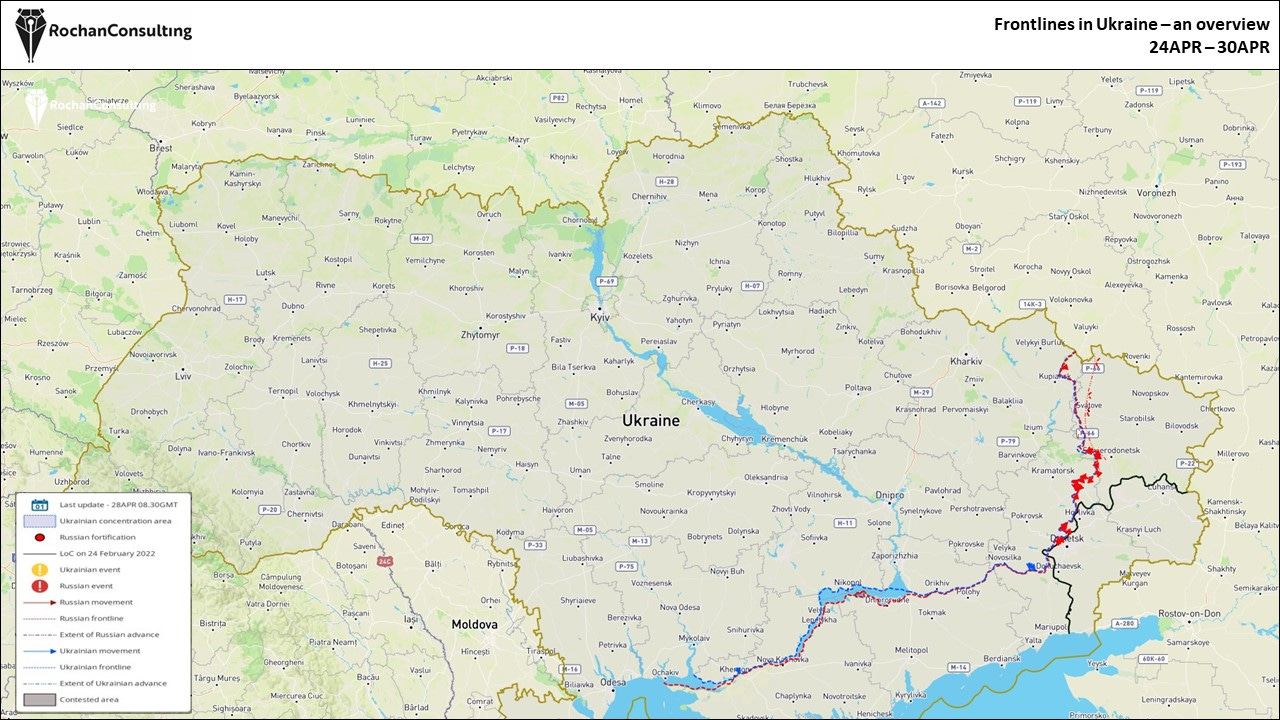

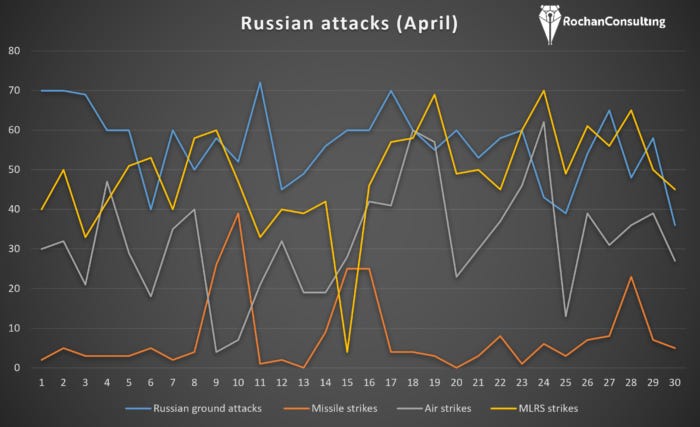
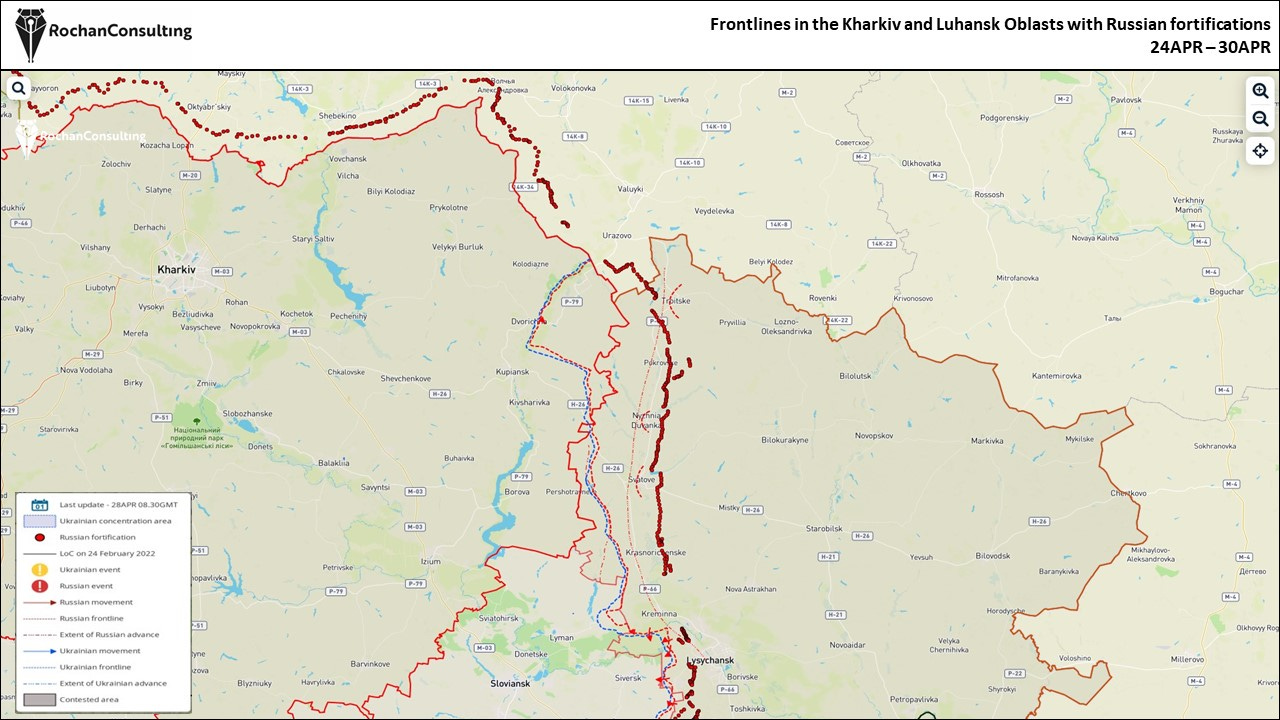
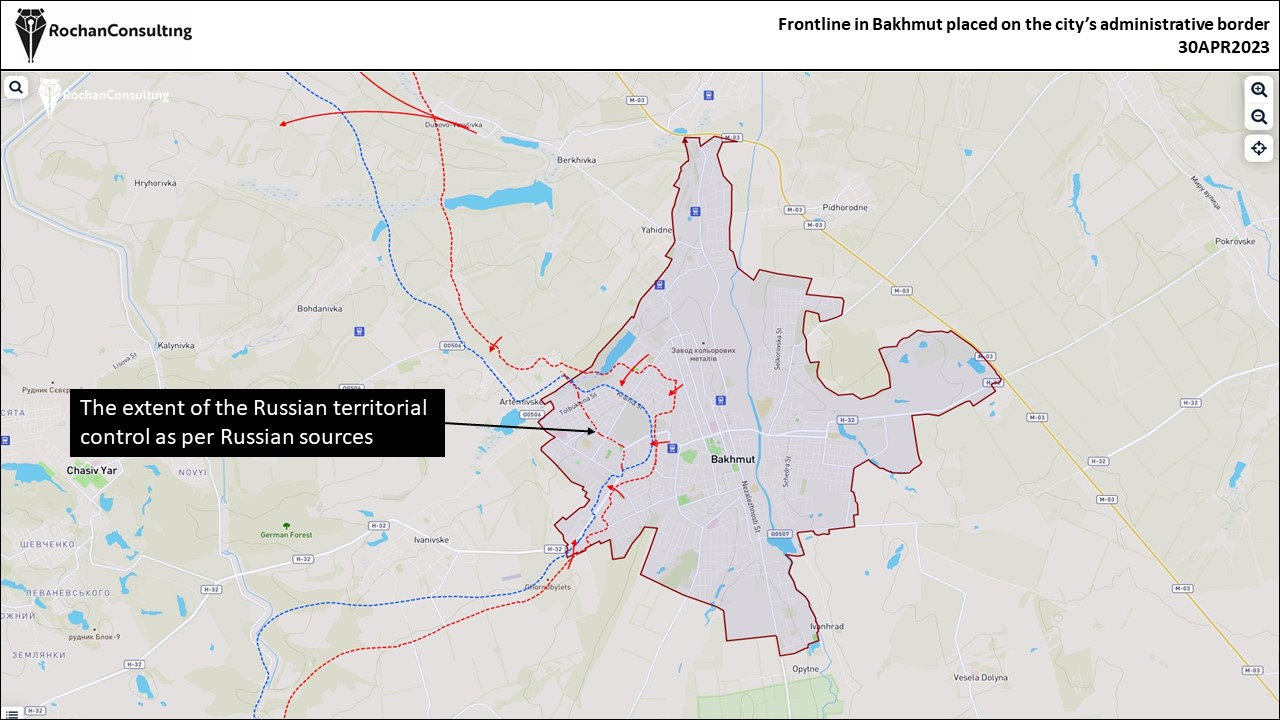
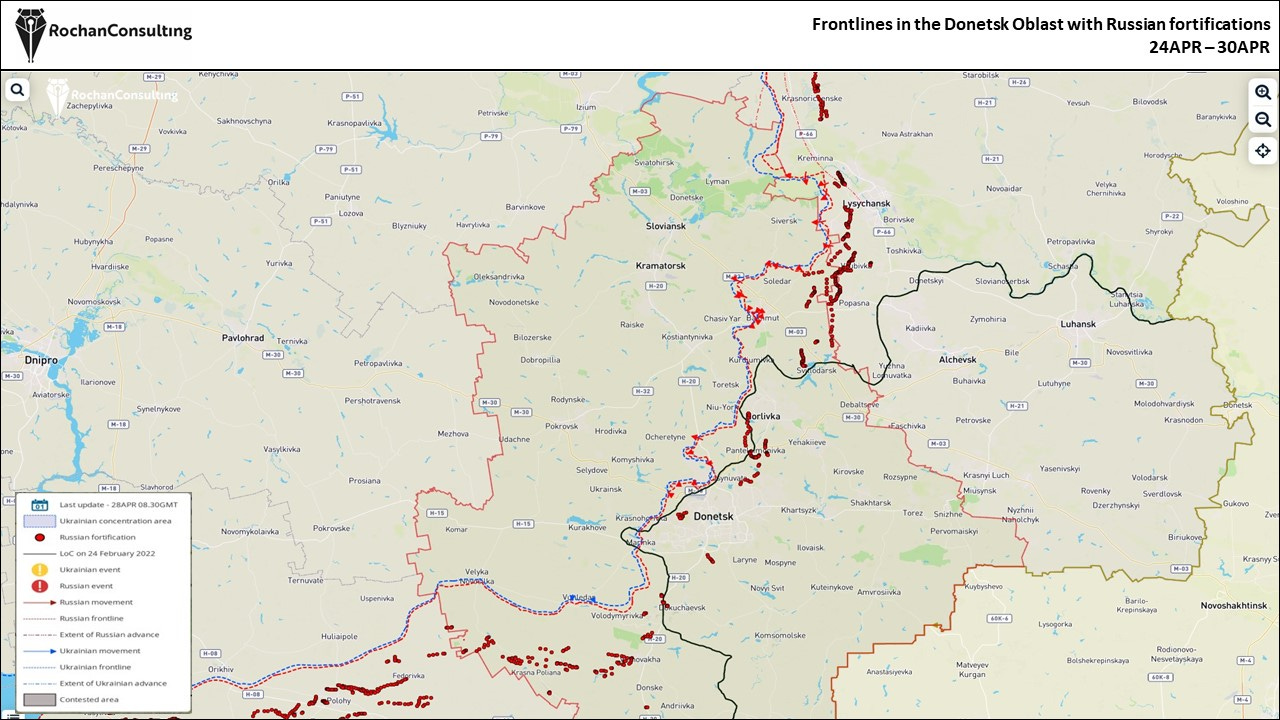
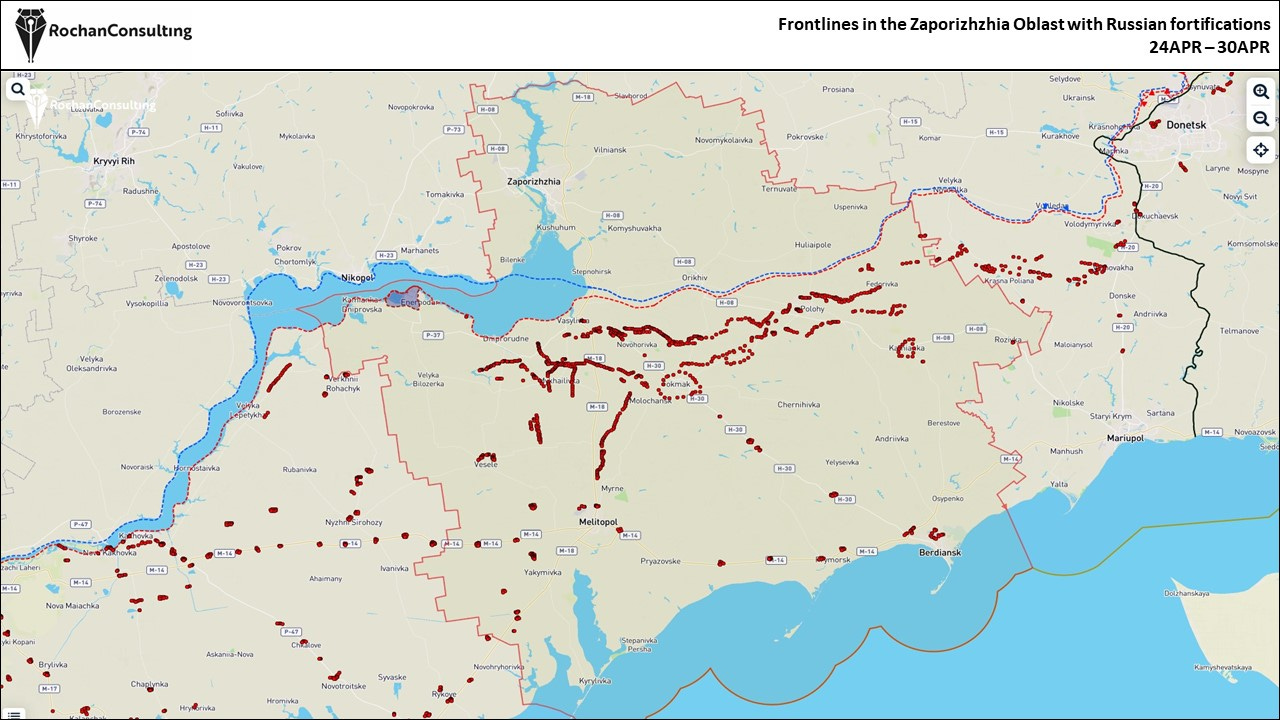
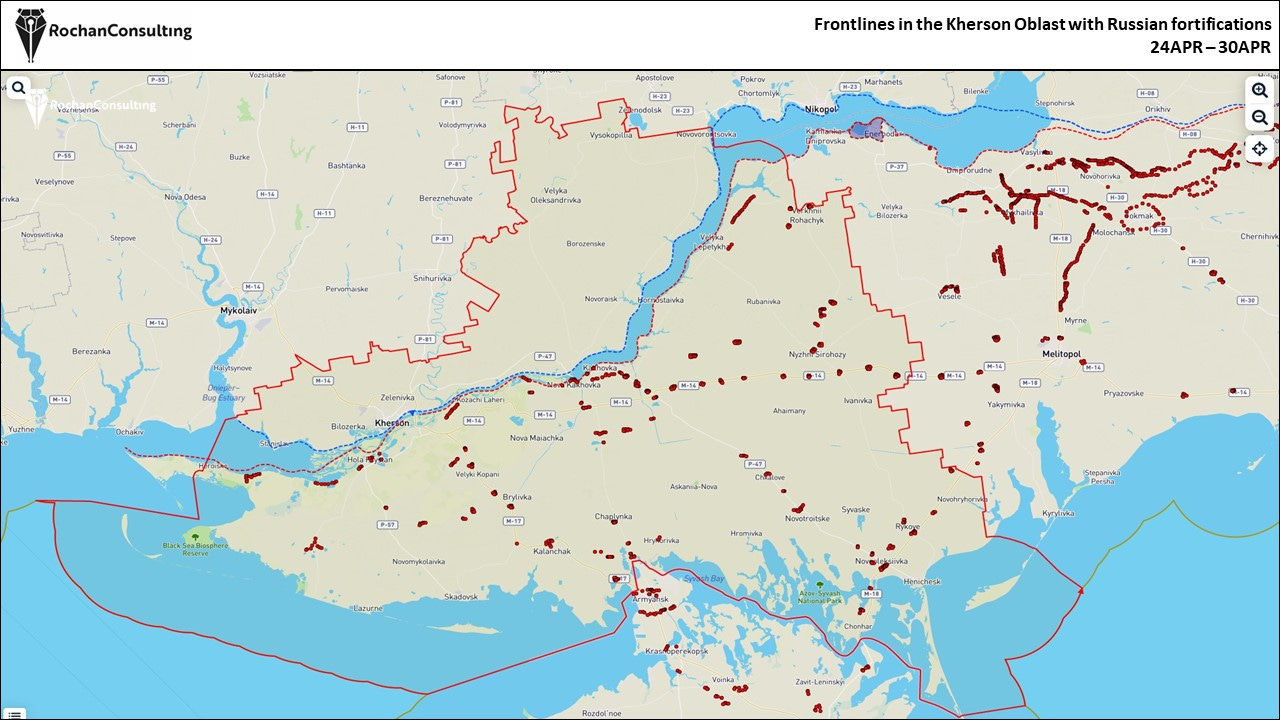

I will enjoy watching western military analysts struggle in vain to map Ukraine's moves onto the outdated main axis/supporting axis schema NATO officers appear to be in love with.
Betcha Ukraine will shift the focus of its attacks several times. They have to be extremely opportunistic, get Russia to expose itself somewhere before committing to a big attack. Ukraine is too big to think of as having only one front with one center of mass and all that old school thinking.